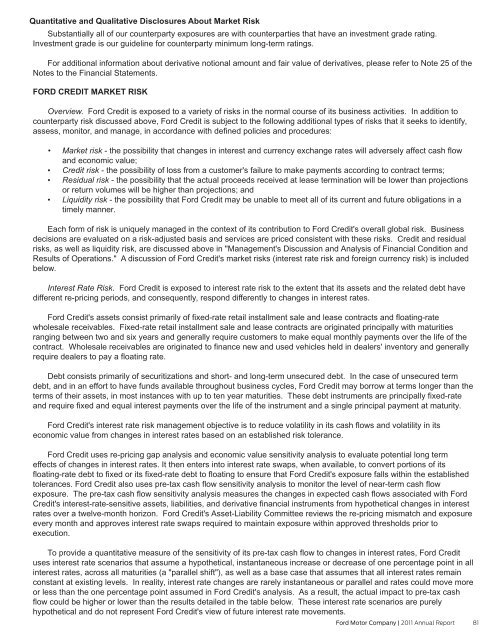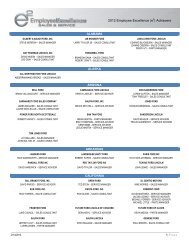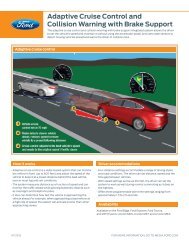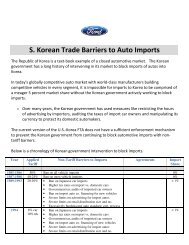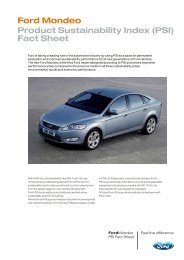Annual Report 2011 - Ford Motor Company
Annual Report 2011 - Ford Motor Company
Annual Report 2011 - Ford Motor Company
You also want an ePaper? Increase the reach of your titles
YUMPU automatically turns print PDFs into web optimized ePapers that Google loves.
Quantitative and Qualitative Disclosures About Market Risk<br />
Substantially all of our counterparty exposures are with counterparties that have an investment grade rating.<br />
Investment grade is our guideline for counterparty minimum long-term ratings.<br />
For additional information about derivative notional amount and fair value of derivatives, please refer to Note 25 of the<br />
Notes to the Financial Statements.<br />
FORD CREDIT MARKET RISK<br />
Overview. <strong>Ford</strong> Credit is exposed to a variety of risks in the normal course of its business activities. In addition to<br />
counterparty risk discussed above, <strong>Ford</strong> Credit is subject to the following additional types of risks that it seeks to identify,<br />
assess, monitor, and manage, in accordance with defined policies and procedures:<br />
• Market risk - the possibility that changes in interest and currency exchange rates will adversely affect cash flow<br />
and economic value;<br />
• Credit risk - the possibility of loss from a customer's failure to make payments according to contract terms;<br />
• Residual risk - the possibility that the actual proceeds received at lease termination will be lower than projections<br />
or return volumes will be higher than projections; and<br />
• Liquidity risk - the possibility that <strong>Ford</strong> Credit may be unable to meet all of its current and future obligations in a<br />
timely manner.<br />
Each form of risk is uniquely managed in the context of its contribution to <strong>Ford</strong> Credit's overall global risk. Business<br />
decisions are evaluated on a risk-adjusted basis and services are priced consistent with these risks. Credit and residual<br />
risks, as well as liquidity risk, are discussed above in "Management's Discussion and Analysis of Financial Condition and<br />
Results of Operations." A discussion of <strong>Ford</strong> Credit's market risks (interest rate risk and foreign currency risk) is included<br />
below.<br />
Interest Rate Risk. <strong>Ford</strong> Credit is exposed to interest rate risk to the extent that its assets and the related debt have<br />
different re-pricing periods, and consequently, respond differently to changes in interest rates.<br />
<strong>Ford</strong> Credit's assets consist primarily of fixed-rate retail installment sale and lease contracts and floating-rate<br />
wholesale receivables. Fixed-rate retail installment sale and lease contracts are originated principally with maturities<br />
ranging between two and six years and generally require customers to make equal monthly payments over the life of the<br />
contract. Wholesale receivables are originated to finance new and used vehicles held in dealers' inventory and generally<br />
require dealers to pay a floating rate.<br />
Debt consists primarily of securitizations and short- and long-term unsecured debt. In the case of unsecured term<br />
debt, and in an effort to have funds available throughout business cycles, <strong>Ford</strong> Credit may borrow at terms longer than the<br />
terms of their assets, in most instances with up to ten year maturities. These debt instruments are principally fixed-rate<br />
and require fixed and equal interest payments over the life of the instrument and a single principal payment at maturity.<br />
<strong>Ford</strong> Credit's interest rate risk management objective is to reduce volatility in its cash flows and volatility in its<br />
economic value from changes in interest rates based on an established risk tolerance.<br />
<strong>Ford</strong> Credit uses re-pricing gap analysis and economic value sensitivity analysis to evaluate potential long term<br />
effects of changes in interest rates. It then enters into interest rate swaps, when available, to convert portions of its<br />
floating-rate debt to fixed or its fixed-rate debt to floating to ensure that <strong>Ford</strong> Credit's exposure falls within the established<br />
tolerances. <strong>Ford</strong> Credit also uses pre-tax cash flow sensitivity analysis to monitor the level of near-term cash flow<br />
exposure. The pre-tax cash flow sensitivity analysis measures the changes in expected cash flows associated with <strong>Ford</strong><br />
Credit's interest-rate-sensitive assets, liabilities, and derivative financial instruments from hypothetical changes in interest<br />
rates over a twelve-month horizon. <strong>Ford</strong> Credit's Asset-Liability Committee reviews the re-pricing mismatch and exposure<br />
every month and approves interest rate swaps required to maintain exposure within approved thresholds prior to<br />
execution.<br />
To provide a quantitative measure of the sensitivity of its pre-tax cash flow to changes in interest rates, <strong>Ford</strong> Credit<br />
uses interest rate scenarios that assume a hypothetical, instantaneous increase or decrease of one percentage point in all<br />
interest rates, across all maturities (a "parallel shift"), as well as a base case that assumes that all interest rates remain<br />
constant at existing levels. In reality, interest rate changes are rarely instantaneous or parallel and rates could move more<br />
or less than the one percentage point assumed in <strong>Ford</strong> Credit's analysis. As a result, the actual impact to pre-tax cash<br />
flow could be higher or lower than the results detailed in the table below. These interest rate scenarios are purely<br />
hypothetical and do not represent <strong>Ford</strong> Credit's view of future interest rate movements.<br />
<strong>Ford</strong> <strong>Motor</strong> <strong>Company</strong> | <strong>2011</strong> <strong>Annual</strong> <strong>Report</strong> 81


